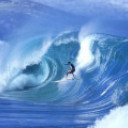Understanding Surf Report Rating


Hi mate
Great topic.. we've been meaning to cover this in an article for a while, but just haven't got around to it.
One of the fascinating things about surfers and surf reports is that everyone assesses things differently. One surfer's poor onshore surf is another surfer's fun empty beachies. Another surfer's perfect sandbottom pointbreak is another surfer's crowded nightmare.
Additionally, the perception of the surf report relates to a couple of other variables, such as:
(1) Where has the surfer (or reporter) been surfing recently? If they've just returned from a fortnight of perfection in the Maldives, then they're going to look at their local surf a little less favourably.
(2) How does the current surf stack up to recent days/weeks/month? A 3ft peaky east swell on the Gold Coast may seem a little bog-standard in March or April (and therefore be worth a lower rating) but if it follows on from a month of tiny surf and gusty northerly winds, a lot of surfers might consider it to be a much higher rating, all things relative.
(3) How about the region where the surf is being reported? If one location within the reporter's ~50km stretch of coastline is all-time, but everywhere else is closing out and unrideable, does the reporter report for the region, or that one epic location? Or somewhere between?
(4) The ability and personality of each surfer (or reporter) often comes into play. I know a few surfers who consider anything less than heaving 4-6ft barrels to be average at best. But, I know other surfers who can turn 1ft beachbreak surf into a fantastic, memorable session. Does the reporter simply report on the environmental conditions (swell quality, wind direction, weather conditions), or try and find a rating that is representative of what readers might experience once they get to the coast? As for swell quality, how about locations where long periods swells favour the reefs and/or points, and short period swells favour the beachies? What if conditions are perfect for the beaches but there are no banks? Etc etc.
(5) And lastly, we also have to factor in the wonderful nature of ever-changing surf conditions. We've all seen the surf go from poor to pumping in a short space of time, and the opposite too - sometimes because of a wind change, sometimes due to the tide, sometimes because the swell is very inconsistent and lully. Should the reporter's rating factor in changes that *might* happen in the next five minutes or five hours, or should they just report on just what they are seeing now?
Anyway, in 2019 I am looking to really hone in on the way we deliver our surf reports, and to tighten up the parameters so that we deliver a much more informative report. We've essentially had the same system in place ever since we started, and it's well overdue for an upgrade and improvement.
All feedback is very much welcome!


Also, here's a loose description framework for the rating. Happy for any feedback on this.
Swellnet Surf Rating Definition (out of 10)
1. Unsurfable - flat and/or unrideable conditions
2. Very poor - low quality surf with poor conditions
3. Below average surf - some surfable waves but generally low quality
4. Average surf - a mix of surfable waves with variable quality
5. Above average surf - reasonable percentage of surfable waves, but with variable conditions at times
6. Good surf - plenty of surfable waves with reasonable conditions
7. Very good surf - plenty of surfable waves with good conditions
8. Great surf - high percentage of quality waves with great conditions
9. Excellent surf - high percentage of quality waves with excellent conditions
10. Epic surf - as good as it gets


yeah theres been times when the surf report around here has been a 6 but after driving 30 ks and not finding a wave i would call a 3 a high call...went home dry.....and thats a lot of spots with different angles etc...nada....but in general its pretty good...love to know if your man ( is there one?)on the ground actually looks or is it done from the cams.?


Also worth mentioning that personally, I've never been a fan of rating systems (for all of the above reasons) - which is why we didn't use them for many years.
The written text should provide much more information - the idea that some surfers make a decision whether to surf or not based solely on a number out of ten baffles me, to be honest.
However, we have to move with the times. Behind the scenes, we've been running an automated forecast rating system (out of ten) for the last few years based on our forecast model data, and we'll deploy that sometime in 2019. Again, I don't feel comfortable about it as a single-use product, but there's seemingly a lot of demand for an easy-to-interpret system like this.


I don’t get out of bed for anything less than a 10


The number rating is not an issue as a lot can change quickly but advising where to go in the report is just wrong. This happens a lot in the Middleton report.


Agree strongly with Raku. Why mention anywhere at all. Often my report mentions somewhere that is actually serviced with a camera.


Re: mentioning locations: we do ask all of our reporters not to mention specific locations in their reports.
However, there are some exceptions.
If a surf spot is very well known and well populated (i.e. Noosa, Snapper Rocks, Manly, Torquay etc) then I don't have a problem with the location being used in a general sense from time to time. If there is any doubt as to the location's popularity, then I recommend that it not be referenced.
What I have gone to great lengths to avoid over the years is specific reference to breaks that are time / tide / wind / size sensitive.
For example, "17th Avenue Palmy has a great lefthand bank that'll be unreal on the 10am low tide". Not only is that kind of reporting disrespectful, it's also setting up an opportunity for surf conditions to change, and the advice to become useless.
So, broad terms of reference are always the best way forward when reporting surf conditions.
But, we also have to keep it interesting for the reporter. Writing about the surf every single day is a challenge in itself, let alone if your vocabularly has been cut in half.
With that in mind, and referring to raku's post about the Middleton report - I'm not sure if I have ever seen specific breaks mentioned in this kind of way. When "Goolwa, Waits and Parsons" are mentioned in a report, it's done with a geographical backing - much in the same way the Gold Coast may reference that "the points will be best this afternoon once the southerly kicks in". I don't ever recall the Middleton report referring to specific banks at Waits or Parsons (or other specific recommendations).
However - and this is where the complexity of providing a national surf report service kicks in - the Victor Harbor region is a little more difficult to report for, because unlike other areas where it's easy to generalised some regions into 'protected spots', 'exposed spots', 'outer points' etc, Victor has none of these. Waits and Parsons pick up more swell than anywhere, yet technically they're more sheltered from Kangaroo Island than the Port Elliot/Middleton stretches. So, they're not 'exposed spots' by definition. But, they also break the mold of 'protected spots' because of the extra size they rake in.
And, there are degrees of 'protected spots' too - how do you distinguish between Middleton (partially sheltered), Chiton/Dump (slightly more sheltered) and then the novelty waves closer to Victor?
So, that's just the Victor Harbor region. Every coastline has its own nuances. And, every surfer also has their own opinion of what should be mentioned and what shouldn't.
It's a tightrope that we'll continue to walk for ever, I suspect.


I pity the South Coast SA surfers at this time of year. Horror show at Middleton this morning. 1-2ft, onshore, short period, no banks, murky water and gutless waves breaking all over the place. So a normal summer’s day...


The rating system is just too subjective to be of any use. As you’ve said the notes cover everything you need to know, and from them you should be able to figure out what it means for you, and your individual preferences. The only people I can personally see valuing a rating system, are people that are just maybe casual (once in a blue moon) surfers, and are not invested into learning their local spots & conditions. They are also most likely not to be subscribers as a result. So if you want feedback I’d definitely vote for canning the whole rating system.


Now there's a bunch of interesting assumptions:
1) Only casual surfers (kooks?) value the rating system
2) Casual surfers have no interest in learning about surf conditions that affect their local surf spot
3) Casual surfers are unlikely to subscribe to Swellnet Pro
(I'd disagree with each of those points).
As I've said before, I don't care much for the rating system, but because there is demand for it - and because it requires very little extra effort to produce - it's here to stay (otherwise, the small volume of feedback we receive questioning the rating system, will morph into a similar volume of feedback about "where has the rating system gone?").
But, I do appreciate the feedback nonetheless! Always interesting to here everyone's views.


I think you've misunderstood what I mean't, or maybe I didn't convey it very well. It's not a "only kooks need a rating system, blah blah" rant. It's a more agreeing with you saying it's so subjective, and that I personally just don't see any value in it.
By casual I don't specifically mean kooks or beginners. I mean people that just don't surf often, which could be due to lots of factors, time/location etc. There's also a difference in my mind between being invested and interested in something. It all comes down to time, and some people might love surfing but don't have time or resources to invest into learning/monitoring locations (swell direction/ tides/banks etc). In that case when they might get a small window to getaway for a surf, they might check a report and just look at the rating and go "ah it's 3/10 that's not good I'm not going". The problem with that again comes down to how subjective that is.
For example, the Surfcoast today has been given a 3/10 rating. It's light offshore, 2ft and sunny. That might be a 10/10 for some people, while for others it might be a 0/10. Likewise when it's rated 10/10 and absolutely pumping, then for some it might be a 0/10 because it's too big for them to surf. This high rated days usually come with wording in the report along the lines of "for experienced/advanced surfers only" so I'll make another assumption :) and assume that not all your user base falls into that category, and that a day where you can't surf isn't a 10/10.
You have all the forecast models, awesome forecast notes, and are generally spot on with everything, so to then have to have this totally subjective number that gets assigned to it kind of dilutes that for me. You obviously have the data that people want it based on your comment, and you're running a business, so maybe it's just something that needs to become more model based, where it's tailored to an individuals preferences.
Happy New Year by the way!


All good mate - and I totally agree with your last post.
I suppose my point is that there's demand for a rating (it was requested for many years), and because it doesn't consume any additional resources, we may as well keep it in.
If nothing else, it gives people something else to whinge about, when the forecast is correct, the surfcams have been cleaned and the editorial's on point.

Hi everyone, I'm new to Swellnet, recently got my subscription here mostly because of the regional forecast, I really like the way the regional forecast is written, the way ben(usually him) explains what is going in and what to expect is nice, it is good to learn about local systems and how it works. Nice job on it.
One thing that confuses me here though is the Surf Report "Rating", the last couple weeks most of the days were really poor surf-wise(here on the goldie) and the rating number has been consistently on the 4/5 range one day it even was 6.
My first understand of this metric, "rating", was that it means "general surf condition", so 4,5,6 would mean average surf conditions but, in my option, the surf was way bellow average lately(maybe we had 1 or 2 good days in the last couple weeks). So I wonder if I'm misunderstanding it.
Would the rating mean something like the following:
0 - flats
1, 2, 3 - levels of poor surf quality, 1 below poor, almost flat, ...., 3 meaning poor
4, 5, 6 - average surf, 4- below average , 5 - average , 6 - a bit over the average
7, 8, 9 - excellent range, good conditions
Am I right about my "rating" assumption?
I'm just trying to get a better understand of the service/tool provided.
Thanks in advance!